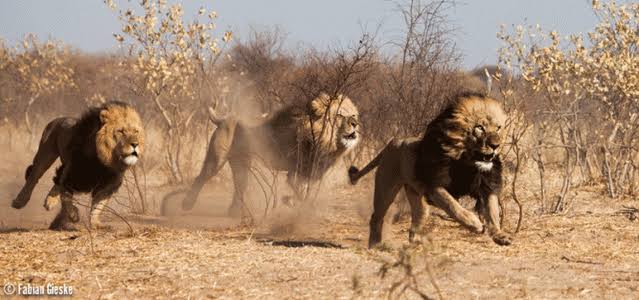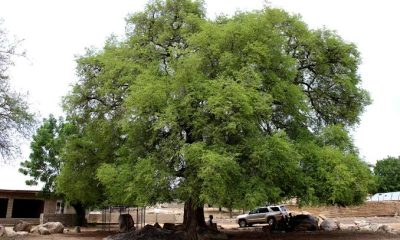News
Unending Search for a Common Ground: Understanding the Dynamics of Human and Wildlife Conflict

Unending Search for a Common Ground: Understanding the Dynamics of Human and Wildlife Conflict
By: Bright Olunusi
The term “wild” implies creatures untouched by the direct influence of humanity, preserving their instincts and behaviors. On the other hand, zoological gardens serve as ex-situ conservation sites, showcasing these magnificent animals to the public, albeit in a tamed and controlled environment. Families flock to zoos for leisure and education, seeking to witness the wonders of nature up close. One of the questions bothering the minds of tourists and non-experts from the field is, are these wild animals truly domesticated?
While years of captivity may temper their ferocity to some extent, labeling them as pets would be a grave misjudgment. Instances abound where wild animals, including lions, have lashed out at unsuspecting visitors, reminding us of the untamed essence that lies beneath their captive facade. Such encounters often end in tragedy, as evidenced by the recent incident at the zoological garden of Obafemi Awolowo University, Ile Ife.
Without prejudice to the university’s ongoing inquiry into the remote cause of the death of Mr. Olabode Olawuyi, a veterinary technician in the zoological garden of the institution, whom the employer claimed had been tendering the nine-year-old lion from birth. Consider the plight of the zookeeper who, for close to a decade, tended to a lion under the mistaken belief of familiarity and safety. Tragedy often struck when zoo users or the attendants ignored the established protocols for handling wild animals. This unfortunate incident serves as a stark reminder of the inherent dangers posed by human-wildlife interactions within captive settings.
Indeed, human-wildlife conflicts manifest in various forms, ranging from loss of life and property to the transmission of diseases. The OAU Ife Zoo incident epitomizes this perilous nexus, underscoring the need for stringent safety measures and heightened awareness among zoo personnel and visitors alike. There are documented instances of wild animals attacking their caregivers, tourists, or those who cross their paths in their wild moments. For instance, in 2017, a harrowing incident unfolded at the Agodi Zoological Gardens when a lion managed to escape from its enclosure, leading to the devastating loss of a zoo curator’s life. This incident led to the temporary closure of the facility by the Oyo state government as a precautionary measure. In a similar vein, a tragic event unfolded in Texas in 2010 when a man was fatally kicked by his pet deer while trying to feed it, necessitating the deer’s euthanization. In 2011, in Indonesia, seven dogs, starved for two weeks, fatally attacked their owner upon his return. In 2012, a horrifying incident occurred at the Pittsburgh Zoo when a toddler fell into an African-painted dog enclosure and was fatally attacked.
To mitigate such human-wildlife conflict (HWC), especially in conservation areas, several safety precautions must be adhered to. Visitors should supervise their children closely to prevent them from wandering off and should refrain from leaning over cages or attempting to view animals from unsafe distances. It is crucial not to touch or feed the animals and to maintain a safe distance from enclosures. Proper sanitation practices, including thorough handwashing after visits, are essential to prevent the transmission of diseases.
Furthermore, zookeepers must exercise caution. They should avoid becoming overly familiar with the animals and must ensure that enclosures and cages are securely locked before and after feeding times. Regular inspections should be conducted to identify and address any structural weaknesses or faults in facilities.
In conclusion, as a wildlife conservationist who has witnessed firsthand the delicate balance between human presence and animal instincts, I implore greater vigilance and respect for the wild within captive environments. Only through fostering a deeper understanding of wildlife behavior and implementing robust safety protocols can we mitigate the risks inherent in our coexistence with these magnificent creatures.
Bright Olunusi
Boston University, Massachusetts, USA.
brightolunusi@gmail.com
Unending Search for a Common Ground: Understanding the Dynamics of Human and Wildlife Conflict
News
U.S. president orders deadly strikes against ISIS militants in northwest Nigeria

U.S. president orders deadly strikes against ISIS militants in northwest Nigeria
By: Zagazola Makama
President Donald J. Trump announced that the United States had launched a powerful and deadly military strike against Islamic State (ISIS) terrorist targets in Nigeria, in response to what he described as ongoing attacks on primarily innocent Christians in the region.
In a post on his social media platform, Mr. Trump said the operation was conducted “at my direction as Commander in Chief” and targeted ISIS militants whom he accused of “viciously killing, primarily, innocent Christians, at levels not seen for many years, and even centuries.”
The president said he had previously warned the extremist group to halt attacks on Christians or face consequences, adding: “tonight, there was.”
Mr. Trump described the strikes as “numerous perfect strikes, as only the United States is capable of doing,” and reiterated that under his leadership the U.S. would not allow “Radical Islamic Terrorism to prosper.” He extended Christmas greetings to U.S. military forces and said there would be “many more” such strikes if the killing of Christians continued.
The announcement marks a significant escalation of U.S. military involvement in Nigeria’s complex security landscape. Western and Nigerian officials have long warned that militant groups such as ISIS’s West Africa Province (ISWAP) and Boko Haram pose a persistent threat in northern Nigeria, where attacks on civilians including Christians and Muslims alike have killed thousands over the past decade.
Reactions to the U.S. action are still emerging. The strikes come amid ongoing debates over Nigeria’s sovereignty and the best approach to combat extremist violence in West Africa. Previous statements by the Nigerian government welcomed U.S. assistance in fighting terrorism provided it respects the country’s territorial integrity.
The full military impact of the operation including casualties among militants or its implications for Nigeria’s internal security strategy has not yet been independently verified.
End
News
VP Shettima: Borno Attack Will Not Break Nigeria’s Resolve

VP Shettima: Borno Attack Will Not Break Nigeria’s Resolve
By: Our Reporter
Vice President Kashim Shettima has condemned in strong terms the bomb explosion that claimed about five lives and left several others injured at a Mosque in Gamboru Market, Maiduguri, Borno State, describing the attack as a despicable assault on innocent citizens and the peace of the nation.
The Vice President said President Bola Ahmed Tinubu has ordered an immediate intensification of security operations in Borno State following the incident.
In a statement on Thursday, the Vice President condemned the attack, assuring that the Federal Government is deploying additional tactical teams to the area to track down and apprehend those responsible for the terror attack.
“The Federal Government will not tolerate any attempt to undermine the peace and security of our nation. Our security agencies are working round the clock to ensure that the perpetrators of this heinous crime are brought to justice immediately,” he said.
Senator Shettima expressed confidence that the security architecture currently in place would not only apprehend the perpetrators but also unravel the full circumstances surrounding the incident.
“We sympathize with the Government of Borno State, residents, and families who have lost their loved ones in this attack. The Federal Government is confident that those responsible for this despicable act of terrorism will face the full weight of the law,” VP Shettima said.
He assured Nigerians that the Tinubu administration’s commitment to national security, anchored in constitutional duty, remains unwavering.
“Since President Bola Ahmed Tinubu assumed office in 2023, this administration has consistently reaffirmed its unyielding commitment to safeguarding the security, unity, and stability of our nation.
“This commitment remains steadfast under God and the Constitution of the Federal Republic of Nigeria. We will continue to provide our security agencies with all necessary resources and support to decisively defeat terrorism in all its forms,” he affirmed.
The Vice President added that the Federal Government is working closely with state authorities and local security agencies to ensure protection of vulnerable communities and critical infrastructure across the North East and other regions.
VP Shettima: Borno Attack Will Not Break Nigeria’s Resolve
News
Zulum-“Protect Our Sacred Bond,” Celebrates Peaceful Year in Christmas Message

Zulum-“Protect Our Sacred Bond,” Celebrates Peaceful Year in Christmas Message
By: Our Reporter
With profound gratitude to God for sparing our lives one full year to another Christmas celebration, Borno State Governor, Professor Babagana Umara Zulum felicitate with the Christian community across the state on the occasion of Christmas.
The Governor is currently engaged in a four-day security and resilience building tour across Northern Borno. The tour includes visits to military formations to boost their morale, and to communities affected by the insurgency, where he is working to build their confidence and provide tangible democratic benefits.
In a message by his Spokesperson Dauda Iliya, Governor Zulum expressed gratitude to God Almighty for the return of relative peace in the state.
“For us in Borno State, the period between the 2024 to the 2025 Christmas celebrations has been one full year of celebrating enviable all-encompassing reconstruction and recovery,” Zulum stated.
“The progress is not only in terms of physical infrastructure, but also in terms of the peace and forbearance, mutual goodwill and harmonious coexistence among the Muslim and Christian communities, which our beleaguered state very critically desires to launch itself back to prosperity and glorious past,” he added.
“I feel obliged to express my most heartfelt gratitude to God for enabling me to preside over the state one full year, witnessing a gladdening restoration and maintenance of these required peace, mutual goodwill and harmony between the the Muslim and Christian communities which bonded us tightly together as a solid people, but which the over a decade Boko Haram insurgency threatened to completely destroy.
“A noteworthy part of the Muslim-Christian harmonious coexistence and goodwill reconstruction and maintenance was my recent high-level consultation meeting with the leadership of Jama’atu Nasril Islam (JNI) and Christian Association of Nigeria (CAN), focused on strengthening collaborative efforts between the state government and religious bodies to combat the lingering threat of insecurity and foster lasting peace in Borno State.
“At that meeting, I underscored the critical role of religious leaders in promoting tolerance, unity and peace across the state because Borno, like many states, has unique and beautiful family composition dynamics.
“It is common to find under one roof, brothers and sisters, uncles and aunts, who profess different faiths. We share meals, we celebrate festivities and milestones, we grieve losses together, as one family, bound by blood and love that transcends religious labels. This is our reality.
“I stressed that our enviable strength emanates from this reality. I will still, therefore, stress that we must protect this sacred bond within our homes and allow it to define our individual, as well as intra- and cross-community engagements.
“In sustenance of my tradition of just, fair and equitable treatment of both communities in festive seasons, I have, also, this year, I announced support to the Christian community and non indigenes, which includes free transportation to non-indigenes to different parts of the country, humanitarian support to over 6,000 vulnerable Christians, cash gifts to widows and orphans, sponsorship of Christian pilgrimage and other interventions.
I am always disposed to rendering such support, and even more, whenever the need arises.
Governor Babagana Zulum urge every citizen of the state, irrespective of faith, to come together in the collective search for lasting security, peaceful and harmonious coexistence as the most-critical foundation for true reconstruction, recovery and prosperity.
Zulum-“Protect Our Sacred Bond,” Celebrates Peaceful Year in Christmas Message
-

 News2 years ago
News2 years agoRoger Federer’s Shock as DNA Results Reveal Myla and Charlene Are Not His Biological Children
-

 Opinions4 years ago
Opinions4 years agoTHE PLIGHT OF FARIDA
-

 News8 months ago
News8 months agoFAILED COUP IN BURKINA FASO: HOW TRAORÉ NARROWLY ESCAPED ASSASSINATION PLOT AMID FOREIGN INTERFERENCE CLAIMS
-

 Opinions4 years ago
Opinions4 years agoPOLICE CHARGE ROOMS, A MINTING PRESS
-

 News2 years ago
News2 years agoEYN: Rev. Billi, Distortion of History, and The Living Tamarind Tree
-

 ACADEMICS2 years ago
ACADEMICS2 years agoA History of Biu” (2015) and The Lingering Bura-Pabir Question (1)
-

 Columns2 years ago
Columns2 years agoArmy University Biu: There is certain interest, but certainly not from Borno.
-

 Opinions2 years ago
Opinions2 years agoTinubu,Shettima: The epidemic of economic, insecurity in Nigeria





